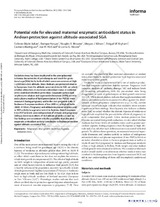Mostrar el registro sencillo del ítem
Potential role for elevated maternal enzymatic antioxidant status in Andean protection against altitude-associated SGA
| dc.contributor.author | Julian, Colleen Glyde | |
| dc.contributor.author | Vargas, Enrique | |
| dc.contributor.author | Browne, Vaughn A. | |
| dc.contributor.author | Wilson, Megan J | |
| dc.contributor.author | Bigham, Abigail W | |
| dc.contributor.author | Rodríguez, Carmelo | |
| dc.contributor.author | McCord, Joe M | |
| dc.contributor.author | Moore, Lorna G | |
| dc.date.accessioned | 2016-09-27T13:49:47Z | |
| dc.date.available | 2016-09-27T13:49:47Z | |
| dc.date.issued | 2012 | |
| dc.identifier.uri | http://repositorio.umsa.bo/xmlui/handle/123456789/8042 | |
| dc.description.abstract | Oxidative stress has been implicated in the uteroplacental ischemia characteristic of preeclampsia and small-for-gestational-age (SGA) birth, both of which are more common at high (>2500 m) vs low altitude. Since Andeans are protected relative to Europeans from the altitude-associated rise in SGA, we asked whether alterations in maternal antioxidant status or oxidative stress contributed to their protection. Enzymatic antioxidant (erythrocyte catalase and superoxide dismutase [SOD]) activity and a plasma marker of lipid peroxidation (8-iso-PGF2α) were measured during pregnancy and in the non-pregnant state in Andean or European residents of low (400 m) or high altitude (3600–4100 m). Pregnancy and altitude increased catalase and/ or SOD activity to a greater extent in Andeans than Europeans. 8-iso-PGF2α levels were independent of altitude and pregnancy. SOD was lower in mothers of SGA infants at weeks 20 and 36. Our findings are consistent with the possibility that elevated enzymatic antioxidant activity contributes to Andean protection against altitude-associated SGA. | es_ES |
| dc.language.iso | en | es_ES |
| dc.publisher | The Journal of Maternal-Fetal and Neonatal Medicine | es_ES |
| dc.subject | ADAPTACIÓN | es_ES |
| dc.subject | HIPOXIA | es_ES |
| dc.subject | ESTRÉS OXIDATIVO | es_ES |
| dc.subject | RESTRICCIÓN CRECIMIENTO FETAL | es_ES |
| dc.title | Potential role for elevated maternal enzymatic antioxidant status in Andean protection against altitude-associated SGA | es_ES |
| dc.type | Article | es_ES |

